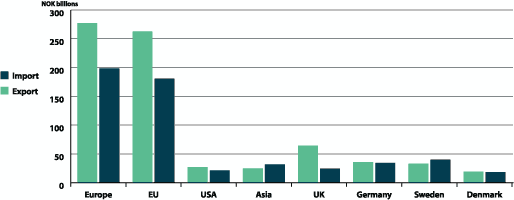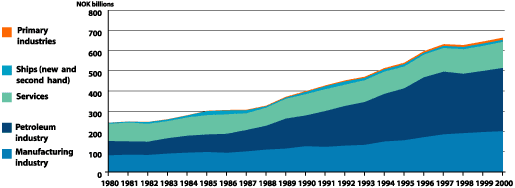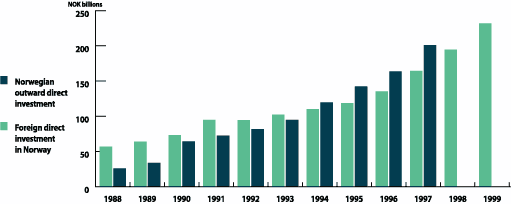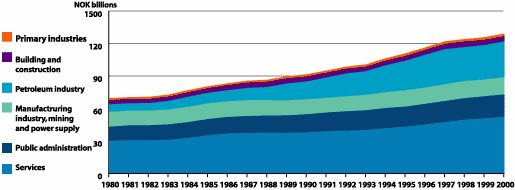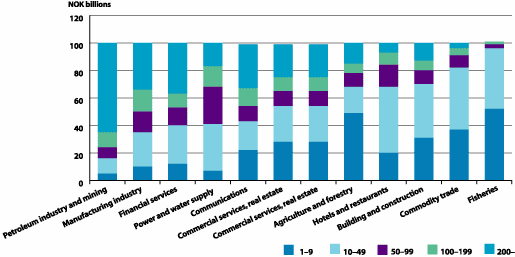Business and industry in Norway - The structure of the Norwegian economy
Guidelines/brochures | Date: 26/06/2001 | Ministry of Trade, Industry and Fisheries
Originally published by: Ministry of Trade and Industry
- Trade with selected regions and countries
- Export trends over the past 20 years
- Main export goods
- Direct investments in companies in Norway and abroad - expansion abroad
- Value creation over the past 20 years
- The employment structure in industry
- Some key bodies in the industrial-policy system
Trade with selected regions and countries
The Norwegian economy is small and the country has a relatively uniform industrial structure. Compared with many other countries, therefore, it has a high share of exports and imports. A major part of Norway’s exports and imports is to and from areas near to us, as shown by the figure below. Seventy-four per cent of Norway’s exports go to the EU, while just over 68 per cent of its imports come from this area. Exports to the USA are at around the same level as those to Asia, but Norway imports much more from Asia than the USA. The Nordic countries, the UK and Germany are Norway’s most important trading partners. The UK and Germany buy significantly larger amounts of Norwegian export products than Sweden or Denmark, for instance. This is due, among other things, to the fact that the first two countries are large markets for Norway’s oil and gas. Sweden is the individual country from which we import most goods.
Norwegian exports/imports to/from selected regions and countries, 1999
|
|
|
|
|
|
|
|
| Source: Statistics Norway (exports by type of goods, two-digit SITC) Direct investments in companies in Norway/abroad - expansion abroadForeign capital and foreign direct investments in Norwegian companies have been of great significance to the growth of Norwegian industry. The figure below shows that Norwegian investments in foreign companies are now greater than foreign investments in Norwegian industry. Prior to 1994, the situation was the opposite. Norwegian investments abroad have risen strongly over the past decade, and a significant amount of the expansion that has occurred has taken place there. Direct investments have primarily been in the manufacturing industry, and the reasons given for them are often the desire to have access and proximity to new markets, access to knowledge and technology, and access to and the ability to utilise natural resources and reasonably priced labour. A survey conducted by SNF of a selection of Norwegian companies’ activities abroad in 1996 showed that the largest Norwegian companies had 150 000 employees in their subsidiaries abroad (43 per cent of all the companies’ total employees). This is equivalent to around 40 per cent of those employed in manufacturing goods in Norway (with the exception of agriculture). Seventy-six per cent of these companies’ total revenues came from outside Norway. |
|
|
| Source: Norges Bank Value creation over the past 20 yearsThe gross domestic product, or GDP is a measure of the value creation in all the goods and services produced by a country in the space of a year. In 2000, Norway’s total GDP came to NOK 1 424 billion. The private-services sector accounts for 40 per cent of Norway’s GDP, making it the highest contributor. The number employed in the service industries has also grown by 230 000 since 1980. The increase in those employed in business services has been all of 240 per cent. The manufacturing industry accounts for around 9 per cent of the GDP of mainland Norway. The number of people employed in this sector was falling at the beginning of the 1980s, and was around 300 000 in 2000. The estimated value creation in general government currently comprises around 14 per cent of the GDP. Since 1980 and up to the present day, the number of people employed in general government has increased by 250 000, with more than 90 per cent of this growth taking place in local-authority administration. The primary industries account for around 2 per cent of Norway’s GDP. Private services and oil production have been the most important contributors to the growth in GDP over the past 20 years, while the value creation in the manufacturing and construction industries has mainly remained stable throughout this period. Development in GDP by industry, 1980-2000 (fixed 2000 prices) |
|
|
|
|
| Source: Statistics Norway, Register of Companies and Business Enterprises Some key bodies in the industrial-policy systemThe Norwegian Industrial and Regional Development Fund (SND) has, since its formation on 1 January 1993, been an important source of financing for small and medium-sized companies. The SND is the authorities’ key body in the field of industrial and regional development, and focuses on small and medium-sized companies, new companies, competence-increasing measures and female participation in industry, among other things. The Research Council of Norway (NFR) administers almost NOK 3 billion for research purposes, provides advice on research-policy questions and creates meeting places for researchers and users of research. The objectives of the Research Council are to promote basic and applied research in all professional fields, increase society’s level of knowledge and promote creativity in all sectors and industries. The Norwegian Trade Council is intended to be Norway’s national centre of expertise on exports, internationalisation and technological collaboration. Norwegian Industrial Attachés (Norges Industriattachéer) were incorporated into the Norwegian Trade Council as from 1999. The Norwegian Tourist Board is a commercial foundation established in collaboration between the Norwegian government and the travel industries in Norway. This foundation is intended to be a national, professional marketing body for the Norwegian travel industries, and must, through its work, contribute to stimulating and strengthening the travel industries’ overall profitability and competitive ability. The Norwegian Guarantee Institute for Export Credits (GIEK) is the main government body for providing guarantees and insuring export credits. Its main goal is to promote the export of Norwegian goods and services and Norwegian investments abroad.
|
|
| |||
The structure of the
| ||||



